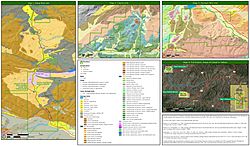John Day Formation facts for kids
Quick facts for kids John Day StrataStratigraphic range: Eocene-Early Miocene |
|
|---|---|

Exposures of the Turtle Cove Formation along a hiking trail in the Sheep Rock Unit of the John Day Fossil Beds National Monument
|
|
| Type | Sedimentary (mostly from clasts of igneous origin), igneous |
| Underlies | Columbia River Basalt Group |
| Overlies | Clarno Formation |
| Lithology | |
| Primary | Sandstone, tuff |
| Other | Pyroclastic |
| Location | |
| Region | Central Oregon |
| Country | |
| Type section | |
| Named for | John Day River |
The John Day Formation is a special collection of rock layers found in central Oregon, USA. These rocks are famous for their amazing colors and the many fossils they hold. You can see these layers in places like the John Day Fossil Beds National Monument.
These rock layers were formed over millions of years. They are mostly made of ash and other materials from ancient volcanoes. The John Day Formation sits between older rocks called the Clarno Formation and younger rocks known as the Columbia River Basalts.
Contents
What are the John Day Rocks?
The John Day Formation is a series of rock layers, or "strata." These layers are found in the John Day River basin in north-central Oregon. They are mainly made of volcanic ash and other volcanic rocks. These materials are rich in a substance called silica.
You can see these rocks in a few different areas. One main spot is the Picture Gorge district. Other places include the Warm Springs district and along the south side of the Ochoco Mountains. These rocks tell a long story about Earth's past.
How the Layers Formed
The rock layers in the John Day Formation are very old. They range in age from about 39 million years to 18 million years old. They were created mostly from ash that fell from ancient volcanoes. These volcanoes were part of a chain linked to what scientists call the Yellowstone hotspot.
Imagine huge clouds of ash and dust erupting from volcanoes. This ash settled down in the John Day basin. Because the ash piled up quickly, it covered and protected plants and animals. This helped to preserve them as fossils.
The ash fell during different times and under various weather conditions. This means the layers have different colors and chemical makeups. For example, the lowest layers are often red, like those seen in the Painted Hills. Above that, you might find pea-green clay, and then buff-colored layers on top.
Important Rock Layers
Within the John Day Formation, there are several key layers. Each layer represents a different time period. Some of these major layers include:
- The Big Basin Formation and Bridge Creek Beds (about 35 to 32 million years old).
- The Turtle Cove Formation (about 30 to 28 million years old).
- The Picture Gorge Ignimbrite (about 28.7 million years old).
- The Kimberly Formation (about 28 to 25 million years old).
- The Haystack Formation (about 25 to 18 million years old).
These different layers help scientists understand how the environment changed over millions of years.
Ancient Life and Fossils
The John Day Formation is a treasure chest for fossil hunters. The rapid burial by volcanic ash helped preserve many ancient plants and animals. Scientists have found a wide variety of fossils here.
Animal Fossils
More than 100 different types of mammals have been found in these rocks. These include ancient versions of animals we know today. You can find fossils of early dogs, cats, horses, and camels. There are also fossils of rodents and unique animals called oreodonts. Oreodonts were plant-eating mammals that looked a bit like pigs or sheep.
Plant Fossils
Plant fossils are also very common in the John Day Formation. One of the most interesting plant fossils is Metasequoia. This is a type of tree known as the Dawn Redwood. For a long time, scientists thought this tree had died out everywhere. But then, living Metasequoia trees were discovered in China in the early 1900s! Finding their fossils here shows they once grew in ancient Oregon.
These fossils help us learn about the plants and animals that lived in Oregon millions of years ago. They also show how environments and life forms have changed over Earth's history.



